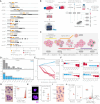A scaleable inducible knockout system for studying essential gene function in the malaria parasite
- PMID: 39739757
- PMCID: PMC11879119
- DOI: 10.1093/nar/gkae1274
A scaleable inducible knockout system for studying essential gene function in the malaria parasite
Abstract
The malaria parasite needs nearly half of its genes to propagate normally within red blood cells. Inducible ways to interfere with gene expression like the DiCre-lox system are necessary to study the function of these essential genes. However, existing DiCre-lox strategies are not well-suited to be deployed at scale to study several genes simultaneously. To overcome this, we have developed SHIFTiKO (frameshift-based trackable inducible knockout), a novel scaleable strategy that uses short, easy-to-construct, barcoded repair templates to insert loxP sites around short regions in target genes. Induced DiCre-mediated excision of the flanked region causes a frameshift mutation resulting in genetic ablation of gene function. Dual DNA barcodes inserted into each mutant enables verification of successful modification and induced excision at each locus and collective phenotyping of the mutants, not only across multiple replication cycles to assess growth fitness but also within a single cycle to identify specific phenotypic impairments. As a proof of concept, we have applied SHIFTiKO to screen the functions of malarial rhomboid proteases, successfully identifying their blood stage-specific essentiality. SHIFTiKO thus offers a powerful platform to conduct inducible phenotypic screens to study essential gene function at scale in the malaria parasite.
© The Author(s) 2024. Published by Oxford University Press on behalf of Nucleic Acids Research.
Figures




Similar articles
-
Investigation of Heterochromatin Protein 1 Function in the Malaria Parasite Plasmodium falciparum Using a Conditional Domain Deletion and Swapping Approach.mSphere. 2021 Feb 3;6(1):e01220-20. doi: 10.1128/mSphere.01220-20. mSphere. 2021. PMID: 33536327 Free PMC article.
-
Robust inducible Cre recombinase activity in the human malaria parasite Plasmodium falciparum enables efficient gene deletion within a single asexual erythrocytic growth cycle.Mol Microbiol. 2013 May;88(4):687-701. doi: 10.1111/mmi.12206. Epub 2013 Mar 26. Mol Microbiol. 2013. PMID: 23489321 Free PMC article.
-
Generation of a new DiCre expressing parasite strain for functional characterization of Plasmodium falciparum genes in blood stages.Sci Rep. 2024 Oct 15;14(1):24076. doi: 10.1038/s41598-024-75657-x. Sci Rep. 2024. PMID: 39402380 Free PMC article.
-
Plasmodium species: master renovators of their host cells.Nat Rev Microbiol. 2016 Aug;14(8):494-507. doi: 10.1038/nrmicro.2016.79. Epub 2016 Jul 4. Nat Rev Microbiol. 2016. PMID: 27374802 Review.
-
Folic acid supplementation and malaria susceptibility and severity among people taking antifolate antimalarial drugs in endemic areas.Cochrane Database Syst Rev. 2022 Feb 1;2(2022):CD014217. doi: 10.1002/14651858.CD014217. Cochrane Database Syst Rev. 2022. PMID: 36321557 Free PMC article.
Cited by
-
A scalable CRISPR-Cas9 gene editing system facilitates CRISPR screens in the malaria parasite Plasmodium berghei.Nucleic Acids Res. 2025 Jan 11;53(2):gkaf005. doi: 10.1093/nar/gkaf005. Nucleic Acids Res. 2025. PMID: 39844455 Free PMC article.
-
A Conditional Cas9 System for Stage-Specific Gene Editing in P. falciparum.bioRxiv [Preprint]. 2025 Mar 10:2025.03.09.642268. doi: 10.1101/2025.03.09.642268. bioRxiv. 2025. PMID: 40161752 Free PMC article. Preprint.
-
Constitutive expression of Cas9 and rapamycin-inducible Cre recombinase facilitates conditional genome editing in Plasmodium berghei.Sci Rep. 2025 Jan 23;15(1):2949. doi: 10.1038/s41598-025-87114-4. Sci Rep. 2025. PMID: 39849074 Free PMC article.
References
-
- de Koning-Ward T.F., Gilson P.R., Crabb B.S.. Advances in molecular genetic systems in malaria. Nat. Rev. Microbiol. 2015; 13:373–387. - PubMed
-
- World Health Organization World Malaria Report 2023. 2023; Geneva: World Health Organization.
-
- Ghorbal M., Gorman M., Macpherson C.R., Martins R.M., Scherf A., Lopez-Rubio J.-J.. Genome editing in the human malaria parasite Plasmodium falciparum using the CRISPR-Cas9 system. Nat. Biotechnol. 2014; 32:819–821. - PubMed
MeSH terms
Substances
Grants and funding
LinkOut - more resources
Full Text Sources
Research Materials

